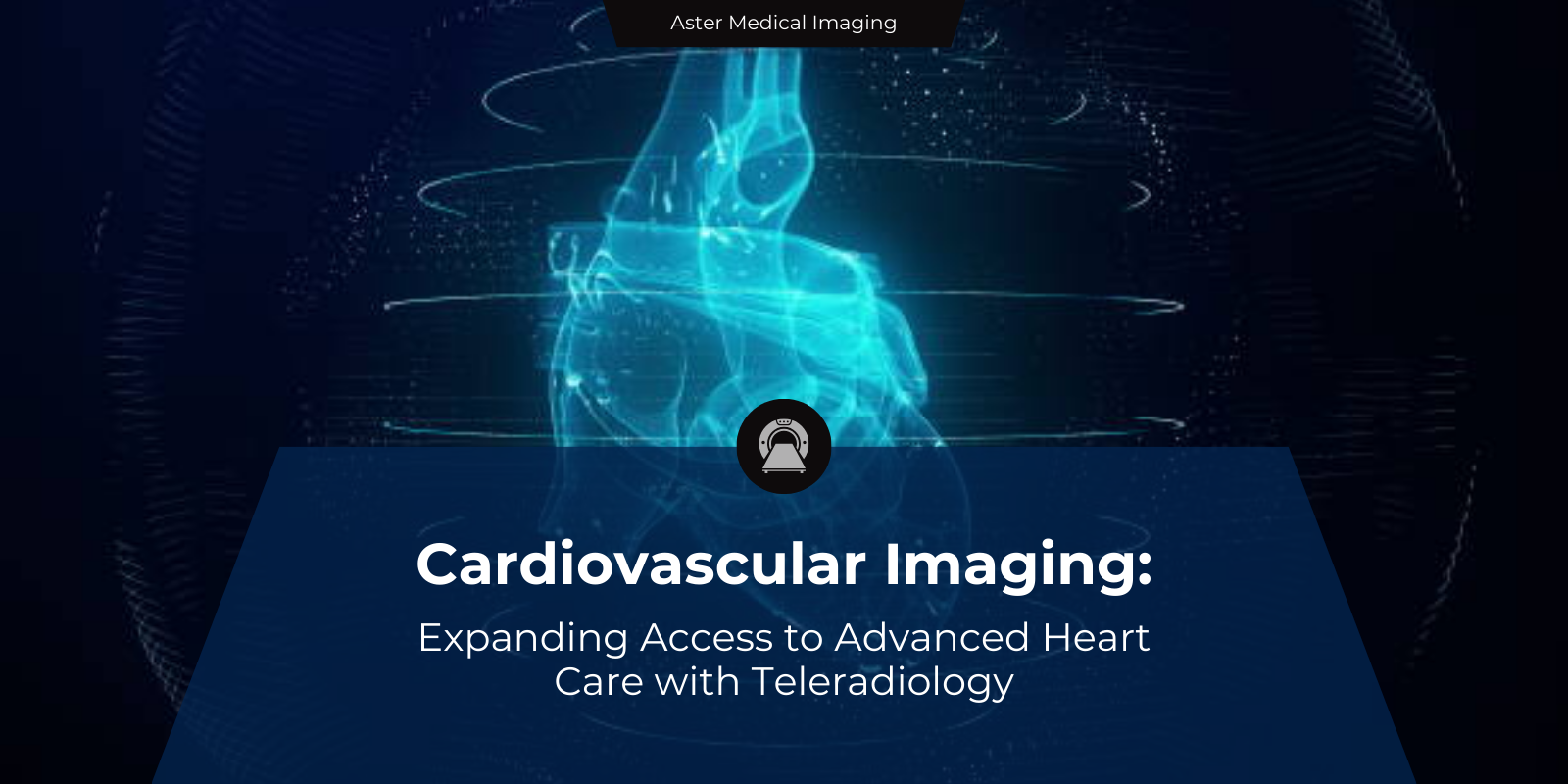

Teleradiology
Cardiovascular Imaging: Expanding Access to Advanced Heart Care with Teleradiology
Introduction
Cardiovascular diseases (CVDs) remain the leading cause of death worldwide, claiming an estimated 17.9 million lives every year. While risk factors like hypertension, diabetes, obesity, and sedentary lifestyles continue to rise, the good news is that early detection and timely management can dramatically improve patient outcomes.
In this context, cardiovascular imaging plays a central role. It allows clinicians to visualize the structure and function of the heart and blood vessels, detect early disease, guide interventions, and monitor treatment success. With the emergence of teleradiology, access to advanced cardiac imaging expertise is expanding globally—even to areas once limited by infrastructure or geography.
The Growing Importance of Cardiovascular Imaging
Cardiovascular imaging is no longer just a supportive tool—it is a cornerstone of modern heart care. Its importance can be seen in multiple ways:
- Rising burden of CVDs globally: With one in every three deaths attributed to heart disease, imaging is vital for prevention and management.
- Early detection of silent heart problems: Imaging can reveal asymptomatic disease, such as early coronary artery narrowing, before symptoms appear.
- Guiding life-saving interventions: Angioplasty, bypass surgery, valve replacements, and device placements rely on imaging guidance.
- Personalized patient care: By providing real-time functional and structural information, imaging helps clinicians tailor therapies to individual patients.
Simply put, without advanced imaging, the fight against cardiovascular disease would be incomplete.
What is Cardiovascular Imaging?
Cardiovascular imaging refers to the use of medical imaging technologies to study the heart and blood vessels. Unlike routine tests like ECG, which record electrical activity, imaging provides a visual assessment of anatomy and function.
It helps answer critical clinical questions such as:
- Is there narrowing or blockage in the coronary arteries?
- How well is the heart pumping blood?
- Are the valves opening and closing properly?
- Is there damage to the heart muscle after a heart attack?
Types and Devices Used in Cardiovascular Imaging
Several imaging modalities are available today, each with unique strengths:
- Echocardiography (ECHO) – An ultrasound of the heart that evaluates structure, pumping function, and valves. Portable and widely available.
- Cardiac CT (Computed Tomography) – A fast, non-invasive method to detect coronary artery disease and calcium deposits.
- Cardiac MRI (Magnetic Resonance Imaging) – Provides detailed imaging of cardiac tissue, blood flow, and function without radiation.
- Nuclear Cardiology (PET/SPECT) – Uses radiotracers to study blood flow (perfusion) and detect ischemia.
- Angiography – The gold standard for visualizing coronary arteries and guiding interventions like stenting.
Devices range from portable ultrasound machines for bedside ECHO to advanced CT and MRI scanners in tertiary care centers. Nuclear medicine cameras (PET/SPECT) and angiography suites complete the toolbox.
Clinical Applications of Cardiovascular Imaging
Cardiovascular imaging informs nearly every aspect of heart care:
- Detecting coronary artery disease and localizing blockages.
- Assessing heart function including ejection fraction and pumping efficiency.
- Identifying congenital heart defects, both simple and complex.
- Evaluating valve diseases, such as stenosis or regurgitation.
- Planning interventions like angioplasty, bypass surgery, or device implants.
- Monitoring treatment effectiveness and detecting complications.
By linking imaging findings with clinical management, doctors can deliver more precise and effective therapies.
Challenges in Accessing Advanced Cardiac Imaging
Despite its importance, access to advanced cardiac imaging is not universal. Key challenges include:
- Geographic limitations – Many rural or remote areas lack advanced equipment like cardiac MRI or nuclear medicine scanners.
- High costs – Advanced imaging modalities are expensive to install and maintain, making them inaccessible for smaller hospitals.
- Shortage of specialists – Even where equipment exists, a lack of trained cardiac radiologists and technologists often limits use.
These barriers mean that millions of patients do not receive timely diagnosis or treatment, particularly in developing nations.
The Role of Teleradiology in Cardiovascular Imaging
Teleradiology is bridging these gaps by enabling remote interpretation of cardiac scans. Through secure, cloud-based platforms:
- Hospitals can connect with cardiac imaging specialists globally for expert opinions.
- 24/7 reporting becomes possible, ensuring urgent cardiac cases are never delayed.
- Small hospitals benefit from subspecialty expertise without needing full-time in-house specialists.
- Standardized protocols and peer reviews improve reporting quality and consistency.
For cardiac emergencies such as suspected heart attack or aortic dissection, teleradiology ensures rapid access to life-saving insights.
How AMI’s Cardiac Radiology and Teleradiology Services Expand Access
At Aster Medical Imaging, we believe access to expert cardiovascular imaging should not depend on geography.
Our services offer:
- A network of specialist cardiac radiologists trained in ECHO, CT, and MRI interpretation.
- Real-time reporting for urgent cases like suspected myocardial infarction.
- Cost-effective solutions that reduce the financial burden on hospitals.
- Global access to advanced imaging expertise, empowering hospitals in both urban and rural areas.
Beyond technology, AMI emphasizes safe radiology practices, peer review, and clinician collaboration to ensure every report is accurate, actionable, and patient-centered.
Future Trends in Cardiovascular Imaging
The future of cardiovascular imaging promises even greater innovation:
- AI-driven image interpretation – Algorithms that detect subtle abnormalities, prioritize urgent cases, and assist radiologists.
- Portable and point-of-care devices – Handheld ultrasound and compact imaging units for bedside or community use.
- Integration with telemedicine – Linking imaging directly with video consultations.
- Wearable health data integration – Combining imaging insights with real-time data from smartwatches and biosensors for continuous monitoring.
Together, these trends will make heart care more proactive, predictive, and personalized.
Conclusion: Expanding Access to Advanced Heart Care
Cardiovascular imaging is not just a diagnostic tool—it is a lifesaving gateway to early detection and treatment of heart diseases. By enabling early interventions, guiding surgical and catheter-based therapies, and monitoring long-term outcomes, it stands at the heart of modern cardiology.
With teleradiology services, advanced imaging expertise is no longer confined to big cities. From rural hospitals to global healthcare networks, patients everywhere can now benefit from timely, accurate, and specialist-driven heart care. The future of cardiology will be more connected, more accessible, and more patient-focused—one image at a time.
FAQs
It is the use of imaging techniques like echocardiography, CT, MRI, and angiography to study the heart and blood vessels.
Ultrasound machines, CT scanners, MRI scanners, PET/SPECT cameras, and angiography systems are the most common.
No. ECG records the heart’s electrical activity but does not produce images. It is a diagnostic test, not an imaging modality.
It helps identify blockages, weak pumping, valve diseases, congenital defects, and early warning signs before major complications occur.
Specialist cardiac radiologists and cardiologists trained in echocardiography, cardiac CT, and MRI interpret complex heart scans and guide treatment.
More from AMI
Imaging Instrumentation Trends In Clinical Oncology
26/06/2023
Revolutionizing Indian Healthcare: Unlocking the Potential of Teleradiology in Remote Areas
27/09/2023
What is Diagnostic Radiology? Understanding its Tests and Procedures
14/08/2023
How Teleradiology Solutions Help Hospitals Cut Turnaround Time
20/08/2025
Emerging Trends and Technologies in Medical Imaging
19/06/2023
Intra- Operative 3D Imaging With O- Arm Making Complex Spine Surgeries Safe and Accurate
30/11/2022
How Teleradiology Reporting Services Are Revolutionizing Frozen Shoulder Diagnosis and Reporting
17/11/2025
How Teleradiology Supports Musculoskeletal Pain Specialists in Diagnosis
20/08/2025
How to Choose a Prospective Teleradiology Service Provider
07/08/2023
Empowering Radiologists-Teleradiology Redefines the Role of Imaging Specialist
09/10/2023
Advances In Neuroradiology
06/01/2023
Teleradiology's Contribution to Timely Emergency Diagnoses
04/10/2023
Scope of Radiologist in India
29/08/2023
Sports-Related Injuries and the Importance of Radiology
30/01/2023
Imaging In Pregnancy
18/01/2023
MRI Spine Thoracic: How Teleradiology Enhances Faster, Accurate Diagnosis
29/09/2025
Behind The Scenes of Teleradiology: How Digital Imaging Is Changing Diagnostic Medicine
16/10/2023
Improvement of Patient Care Through Teleradiology
03/07/2023
How Aster Medical Imaging’s Nighthawk Service Enhances Brain Neuroimaging
29/09/2025
10 Strategies To Prevent Burnout In Radiology
09/01/2023
Radiology Online Reporting: Transforming Diagnosis with Speed and Accuracy
31/07/2025
Emerging Techniques in Radiology By Dr. Namita
10/11/2022
Why Hospitals Prefer Teleradiology Outsourcing for Accurate and Timely MSK Injury Reports
14/11/2025
Radiology Practices
30/11/2022
How to Increase the Efficiency of the Radiology Equipment
21/08/2023
The Future of MRI: Advancements and AI Integration in Online MRI Reporting
19/05/2025

AMI Expertise - When You Need It, Where You Need It.
Partner With Us

